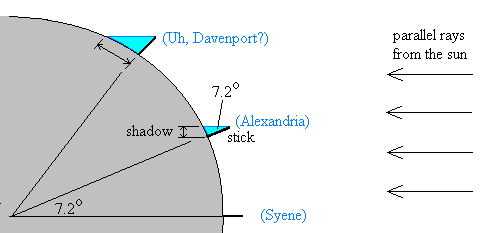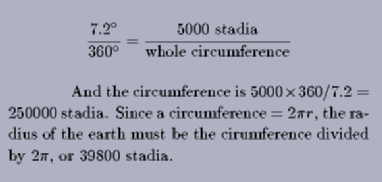Introductory Astronomy: Eratosthenes's measurement
of the size of the earth
The "Alexandrian School" of
Greek thought circa 200 B.C. made astonishing progress in the
understanding of astronomy. One Eratosthenes measured (we believe
quite accurately) the size of the earth. South of Alexandria was a
town called Syene. Eratosthenes heard that, in Syene, on the summer
solstice, the sun shines straight down a very deep vertical well.
(Syene sat on the tropic of Cancer.) On this day in Alexandria, some
5000 "stadia" north of Syene, the sun cast a shadow 7.2
degrees from the vertical. Eratosthenes correctly deduced that this
difference was due to the curvature of the spherical earth:

Furthermore, E. could calculate the
circumference of the earth by analogy:
7.2
degrees is to 360 degrees as 5000 stadia is to ?
The
proportion version of this analogy is:

Our Version
Now we want to repeat E.'s
measurement. We will need a collaborator more than 50 miles north or
south of us to measure a shadow. We will measure the shadow with a
simple stick of known length. I suggest a plumb-bob attachment
(illustrated here as a pencil suporting a paper clip on a thread) so
that you will know that the stick is vertical.

A collaborator is needed because we do
not have a "Syene," and we do not wish to wait for summer
solstice! In our method any old day will do, but the measurement MUST
be taken at local noon, simultaneously at both sites.
Last
modified: Wed Sep 9 15:49:55 CDT 1998



